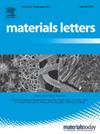High-Temperature oxidation effect of protective thin layers Ta/Cr coatings on Zr-1Nb alloy for corrosion-resistant components of nuclear reactors
IF 2.7
4区 材料科学
Q3 MATERIALS SCIENCE, MULTIDISCIPLINARY
引用次数: 0
Abstract
The study investigated the electrical conductivity and the resistivity of a Zr-1Nb zirconium alloy and the oxidation effect of a Tantalum/Chromium coating under High-Temperature (HT) air oxidation. The coatings were applied using magnetron sputtering, resulting in a Ta barrier sublayer between Cr and Zr substrates. After 1100 °C oxidation for 15–60 min, the coating stopped functioning as a diffusion barrier and started to peel off. Thermoelectromotive force (ThermoEMF), and four probe point (FPP) methods were used to evaluate the structural soundness and effectiveness of the coated zirconium alloys. The findings suggest Ta/Cr coating could be used for nuclear reactor core components in emergency situations.
用于核反应堆耐腐蚀部件的 Zr-1Nb 合金上的 Ta/Cr 保护薄层的高温氧化效应
该研究调查了 Zr-1Nb 锆合金的导电性和电阻率,以及钽/铬涂层在高温(HT)空气氧化条件下的氧化效应。涂层采用磁控溅射技术,在铬和锆基底之间形成 Ta 隔层。在 1100 °C 氧化 15-60 分钟后,涂层停止发挥扩散屏障的作用并开始剥落。热电动势(ThermoEMF)和四探点(FPP)方法用于评估涂层锆合金的结构完整性和有效性。研究结果表明,Ta/Cr 涂层可用于紧急情况下的核反应堆堆芯部件。
本文章由计算机程序翻译,如有差异,请以英文原文为准。
求助全文
约1分钟内获得全文
求助全文
来源期刊

Materials Letters
工程技术-材料科学:综合
CiteScore
5.60
自引率
3.30%
发文量
1948
审稿时长
50 days
期刊介绍:
Materials Letters has an open access mirror journal Materials Letters: X, sharing the same aims and scope, editorial team, submission system and rigorous peer review.
Materials Letters is dedicated to publishing novel, cutting edge reports of broad interest to the materials community. The journal provides a forum for materials scientists and engineers, physicists, and chemists to rapidly communicate on the most important topics in the field of materials.
Contributions include, but are not limited to, a variety of topics such as:
• Materials - Metals and alloys, amorphous solids, ceramics, composites, polymers, semiconductors
• Applications - Structural, opto-electronic, magnetic, medical, MEMS, sensors, smart
• Characterization - Analytical, microscopy, scanning probes, nanoscopic, optical, electrical, magnetic, acoustic, spectroscopic, diffraction
• Novel Materials - Micro and nanostructures (nanowires, nanotubes, nanoparticles), nanocomposites, thin films, superlattices, quantum dots.
• Processing - Crystal growth, thin film processing, sol-gel processing, mechanical processing, assembly, nanocrystalline processing.
• Properties - Mechanical, magnetic, optical, electrical, ferroelectric, thermal, interfacial, transport, thermodynamic
• Synthesis - Quenching, solid state, solidification, solution synthesis, vapor deposition, high pressure, explosive
 求助内容:
求助内容: 应助结果提醒方式:
应助结果提醒方式:


